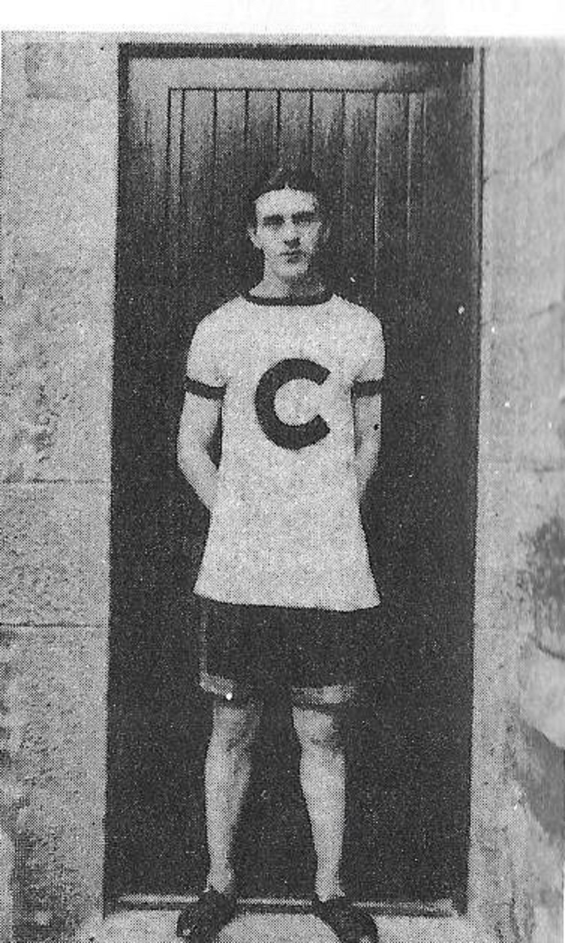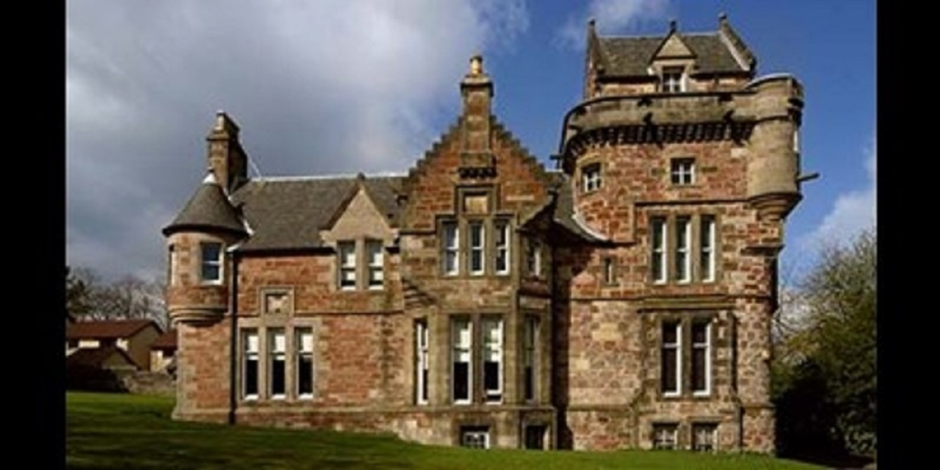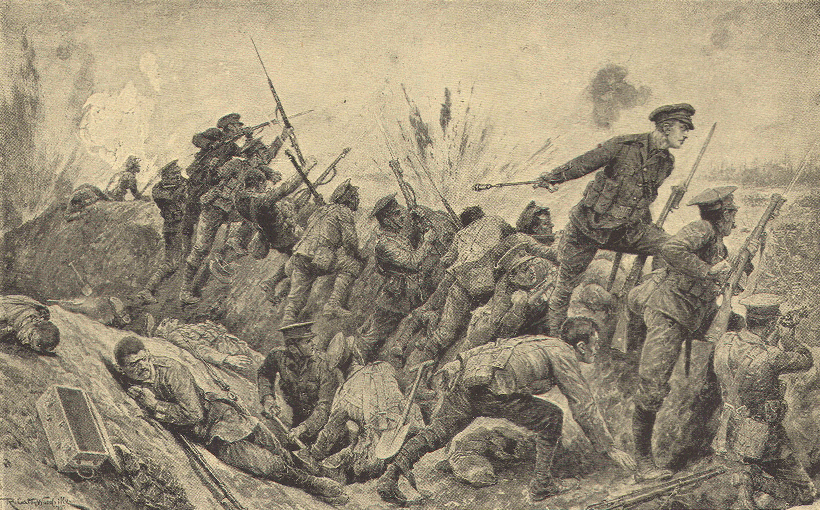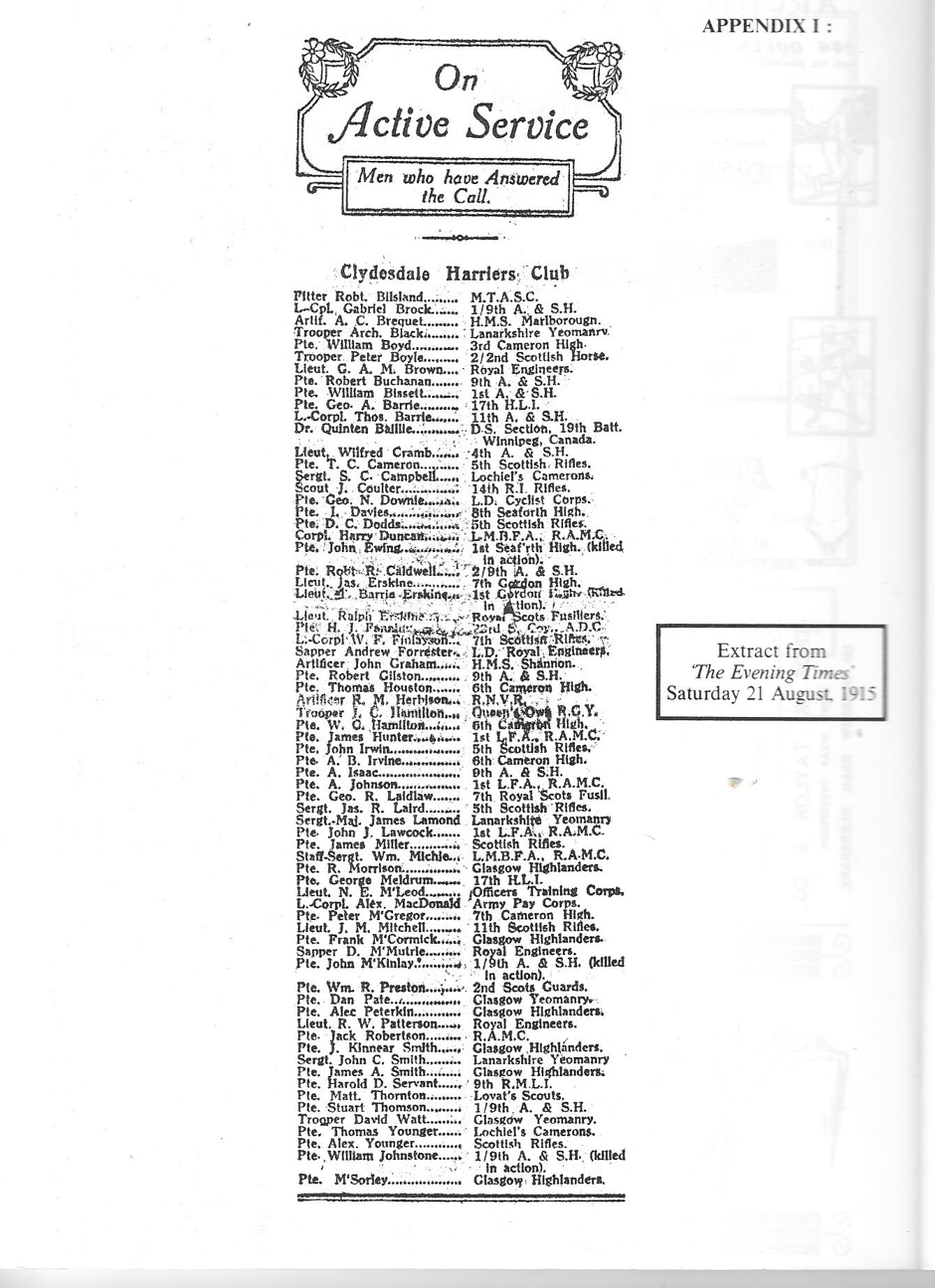…
The photograph above is believed to be that of Gabriel Brock, a member of Clydesdale Harriers who ran in club championships and other cross-country races as well as on the track.
The Brock family was one of the best known and most distinguished in the West of Scotland, he was brought up in the wonderful house shown below and yet. Having been wounded very early in the 1914-18 War he died a tragic death as a result of the treatment of these wounds.
The family were partners in the Denny Shipyard in Dumbarton. The Shipyard was a major feature in the lives of the people of Dumbarton: having been founded as Tulloch & Denny, the name was changed to Denny and Co.in 1862. Walter Brock became a partner in 1871, and Henry William Brock became a partner in 1885. The family remained an integral part of the firm and various members were involved in the local government of the city and the county. They had been patrons of the club, first of the local Dunbartonshire Section then of the Club as a whole from 1894. As patrons of the club they were mixing with senior politicians, minor nobility and major industrial figures.
Gabriel had been born in 1889 in Dumbarton and brought up in Levenford House in Dumbarton, which is illustrated below. His membership application was accepted by Committee on in 8th September, 1911, and he was elected to serve on the General Committee of the club committee at the AGM on 5th September, 1913. He attended regular committee meetings, held at that time in the YMCA in Glasgow, and his first contribution of note was on 11th December, 1913, when the Minute records:
“Mr Gabriel Brock reported that a Dumbarton gentleman, a Mr H Horne, had expressed his willingness to act as a trainer. It was agreed to accept his kind offer, but it was added that Mr McKimmie would again be available also in a short time.”
Not only that, but he was District Convener for the Dunbartonshire Section. The club at that time had 5 sections in Glasgow and five county sections: each section had its own organiser and was represented on the Club Committee, so it was a fairly responsible position.
As a runner, Gabriel was good enough to have won the club’s Two Mile Handicap in season 1912-13. The last meetings in which he competed of which we have records, were the club championships at Ibrox Park in 1914 and the club open meeting at Kilbowie Park in June that year. On 12th May, he ran in the eleventh of sixteen heats of the 100 yards. He must have been quite good because he was off a handicap of 2 yards while Ralph Erskine, a frequent prize winner on the open circuit and double silver medal sinner at the SAAA Championships was off 3 yards. He also ran in the half mile that night when he was running from the 50 yards mark along with three others, one of whom was the Scottish cross-country internationalist Robert Frew and of course Ralph Erskine, twice silver medallist in the SAAA half mile championship was not far behind.
At the Clydebank Meeting he was entered in no fewer than three events. He was one of five entrants in the high jump with a handicap of 7 inches, and he was also entered in the Dunbartonshire County Championships for the 440 yards and the 880 yards. Although unplaced in any of the events, it was a hard afternoon.
He had qualified from the first Ibrox meeting for the finals which were held on 5th August, again at Ibrox Stadium. He was again off 2 yards, only two men starting behind him. He had also qualified for the final of the half mile and, starting from 50 yards, was conceding 70 yards to a group of ten men running from 120 yards. Two of that ten would also lose their lives in the war, as would at least another four with Tom Erskine being the first to go – in July 1915, less than a year later.
It is of interest to note that at many of those competing at this meeting died in the War that started in September – Brock and Tom Erskine in 1915, Ralph Erskine and Alex Younger in 1918. James Marshall Mitchell and Wilfred Cramb in 1917 and Harold Servant in 1919 and many others such as RW Patterson and James Miller.
The Brock family initially stayed in Spittal Cottage in Victoria Street in Dumbarton, before moving to Levencroft House, above.
When the War started, Gabriel joined up with many other members of the club. Indeed many sportsmen from all sports joined up to fight the war which would be over by Christmas, they were told. Like other friends in the club he was to meet a tragic end very early in the war.
One of the many notorious battles of the War was that at Ypres with the fighting at Hill 60 being particularly ferocious. As a member of the 8th/9th Argyll & Sutherland Highlanders, he may gave been involved in the tunnelling at Hill 60. The following is from Wikipedia:
In Spring 1915, earlier French preparations to raid the hill were continued by the British 28th Division, which took over the line in February 1915 and then by the 5th Division. The Allied plan to attack Hill 60 was expanded into an ambitious attempt to capture the hill, despite advice that Hill 60 could not be held unless The Caterpillar nearby was also occupied. A French 3 by 2 feet (0.91 m × 0.61 m) mine gallery under the hill was extended by experienced miners from Northumberland and Wales, after it was found that Hill 60 was the only place in the area not waterlogged.
In the first attack of the newly formed Royal Engineer tunnelling companies in the Ypres Salient, the 173rd Tunnelling Company laid six mines by 10 April 1915, an operation planned by Major-General Edward Bulfin, commander of the 28th Division and continued by the 5th Division after the 28th Division was relieved.[7] The 173rd Tunnelling Company began work early in March and three tunnels were begun towards the German line about 50 yards (46 m) away, a pit first having been dug some 16 feet (4.9 m) deep; the tunnels were more than 100 yards (91 m) long.[8][9] Two more mines in the north were charged with 2,000 pounds (910 kg) of explosives each, two mines in the centre had 2,700 pounds (1,200 kg) charges and in the south, one mine was packed with 500 pounds (230 kg) of guncotton although work on it had been stopped when it ran close to a German tunnel.[10] The attack began on 17 April and the 5th Division captured the area quickly with only seven casualties but found that the new salient made permanent occupation of the hill very costly.
Loss of Hill 60
On 1 May, after a bombardment by heavy artillery, the Germans released chlorine gas at 7:00 p.m., from positions fewer than 100 yards (91 m) away from Hill 60, on a front of 0.25-mile (0.40 km). The gas arrived so quickly that most of the British were unable to put on their improvised respirators. As soon the gas arrived, the Germans attacked from the flanks with bombing parties and artillery laid a barrage on the British approaches to the hill. Some of the British returned fire and reinforcements arrived by rushing through the gas cloud and bombing parties forced the Germans back. The original garrison lost many casualties in standing their ground, including many gas casualties.
The 5th Division held the hill on a 1.25 miles (2.01 km) front with the 15th Brigade on 5 May, when the Germans discharged gas from two places opposite the hill at 8:45 a.m.[13] The wind blew the gas along, rather than across, the British defences and only one sentry was able to sound the gas alarm. The British defence plan required troops under gas attack to move to the flanks but the course of the gas cloud made this impossible. The gas hung so thick that it was impossible to remain in the trenches and troops who stood their ground were overcome. The German 30th Division advanced fifteen minutes after the gas cloud and occupied nearly all of the front line on the lower slope of the hill. British reinforcements bombed up a communication trench and two more battalions were sent forward but before they arrived, the Germans released another gas cloud at 11:00 a.m. to the north-east of the hill.
The right flank of the Zwarteleen Salient was overrun, which increased the gap left by the first discharge; a few men on the left delayed the German infantry until 12:30 p.m., when a battalion advanced through the gas cloud and an artillery barrage. Constant counter-attacks forced some of the Germans back and regained several lost trenches. The Germans held on to the crest and released more gas at 7:00 p.m., which had little effect and an infantry attack which followed was repulsed by rifle-fire. At 9:00 p.m., the 13th Brigade arrived and attacked at 10:00 p.m. after a short bombardment the darkness, state of the ground and alert German infantry repulsed the attack, except for a party which reached the top of the hill, then withdrew at 1:00 a.m. under enfilade-fire from the Caterpillar and Zwarteleen, which made the hill untenable. Both sides were exhausted and spent the next day digging-in. At dawn on 7 May, the British attacked with two companies of infantry and attached “bombers” using hand grenades, all of whom were killed or captured. From 22 April – 31 May 1915, the British had 59,275 casualties in the Second Battle of Ypres and the fighting for Hill 60.
Gabriel was wounded very early in the hostilities, which began on 22nd April, as is reported in the following reports.
The first report below is from the Evening Times of 19th November, 1915. .
On Monday last the death took place at Royal Infirmary, Dundee, of Lance Corporal Gabriel Brock, Pioneer Section 1-9th (Dunbartonshire) A & S Highlanders. He was the only son of Mr William Brock, Spittal Cottage Dumbarton, and joined the local regiment at the outbreak of war and proceeded to France in February last. He took part in the fighting around Ypres and Hill 60 and was wounded in the knee by shrapnel on April 26th. As a result of the wounds he had to undergo several operations and for the past six weeks was at Glamis Castle but, taking seriously ill, he was again conveyed by ambulance to Dundee where he died from lockjaw*. Prior to the War, Lance Corporal Brock was employed as a joiner in the Leven Shipyard in Dumbarton.”
Lockjaw is contracted by bacilli infecting an open wound, and is maybe better known now as tetanus
Coverage from the ‘Lennox Herald’ below.
Military Funeral at Dumbarton
“On Friday afternoon last, the remains of Lance Corporal Gabriel Brock, 1/9th Argyll and Sutherland Highlanders were laid to rest with military honours in Dumbarton Cemetery. Lance Corporal Brock, the only son of Mr William Brock, Spittal Cottage, Victoria Street, was wounded near Ypres on 26th April last and brought over to Dundee Royal Infirmary where, after having undergone several operations, he succumbed to lockjaw; His death is regretted by a wide circle of friends. Besides being a popular member of his company and regiment, he was well known locally as a member of the West of Scotland Harriers and the winner of prizes on the track. To trade he was a joiner in the shop of the Leven Shipyard and his funeral was attended by members of the firm, and a large representation of his brother workmen. There was a short, impressive service conducted in Dumbarton Parish Church at which were present a large congregation. Chaplain, the Rev AS Insch, MA, of the 1/9th Argylls, the Rev WW Reid, BD, minister of the church, occupied the pulpit, the latter paying an eloquent tribute to the memory of the deceased. The coffin, which was wrapped in the folds of the Union Jack, was then carried on the shoulders of six sergeants of the regiment and placed in the hearse. A firing party of nineteen men, including a piper and a bugler, was supplied by the 2/9th from Arbroath, and this party preceded the hearse on the way to the cemetery, the piper playing “the Land O’ The Leal”. The officers present were Captain FC Stewart, 1/9th and Lieutenant James Napier, 8/9th A & SH. Representatives from the local Men’s Volunteer Aid Detachment also attended, and there was a large turnout of the general public. At the grave a short burial service was conducted; volleys fired, and “The Last Post” sounded.”
Other than the fact that he is noted as being a member of the rival West of Scotland Harriers, the report is a full a detailed one.
As noted above, lockjaw is contracted by open wounds being infected. Poor Gabriel was moved from one hospital to another while his condition worsened leading to his eventual death. He was only 26 when he died. Like other members of the club such as the Erskine brothers who both lost their lives in the same war, he was able, personable and a bright promising young athlete, popular with his colleagues and it was all brought to naught.
The funeral was a big one in the town – see the pictures below and link them to the text. There is also a clipping from the ‘Evening Times’ which listed some of the Clydesdale Harriers who had enlisted – from all walks of life they had volunteered and at least a dozen of them died in the conflict.
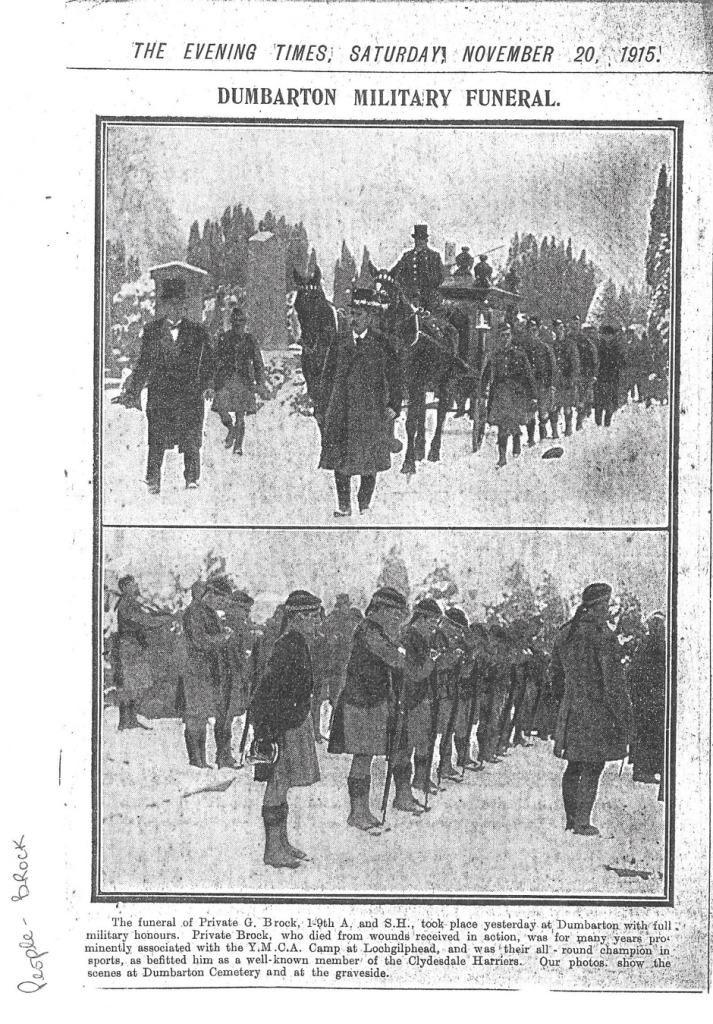 .
.
The list below appeared on 21st August, three months later he would be dead. Many of the other above also made the supreme sacrifice – the two Erskine brothers being notable losses and contemporaries of Gabriel mentioned above, Alex Younger, Wilfred Cramb, J Marshall Mitchell, Harold D Servant, Gilbert AM Brown and others.
